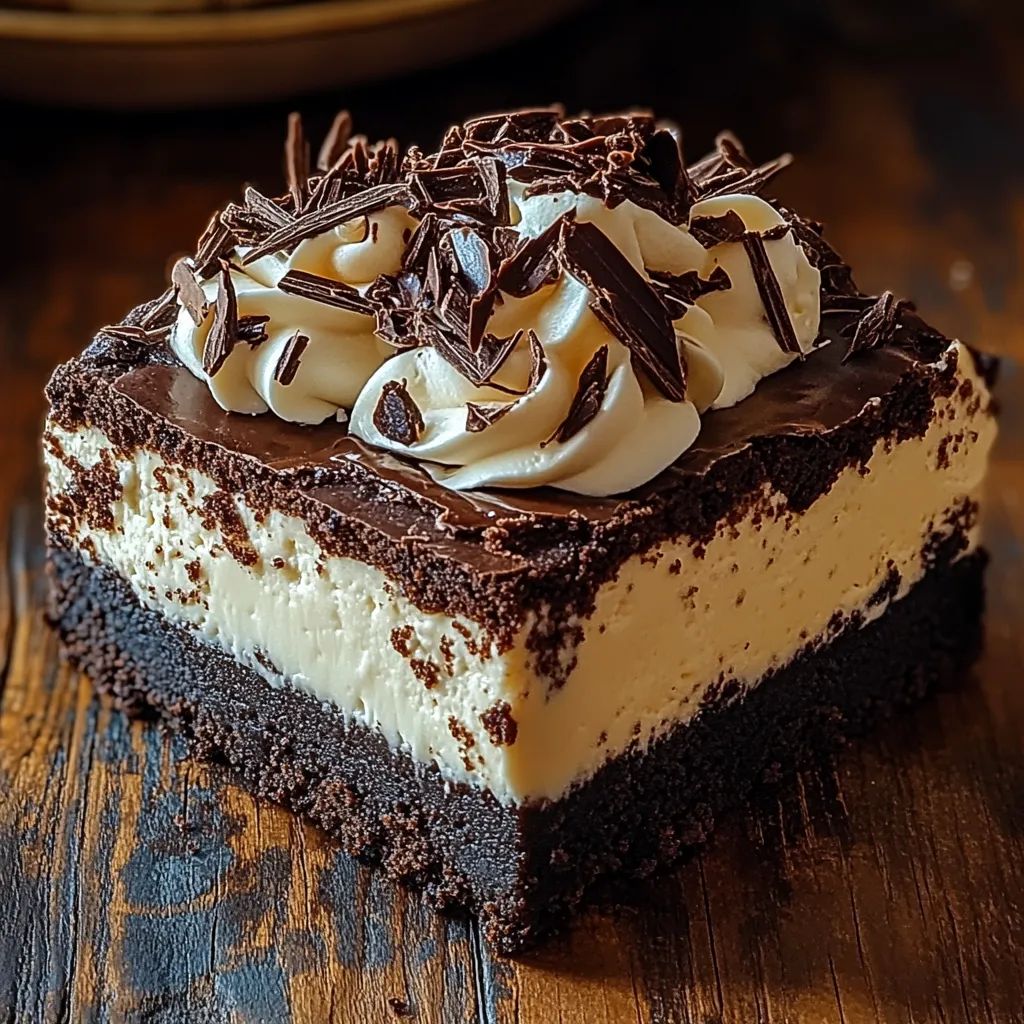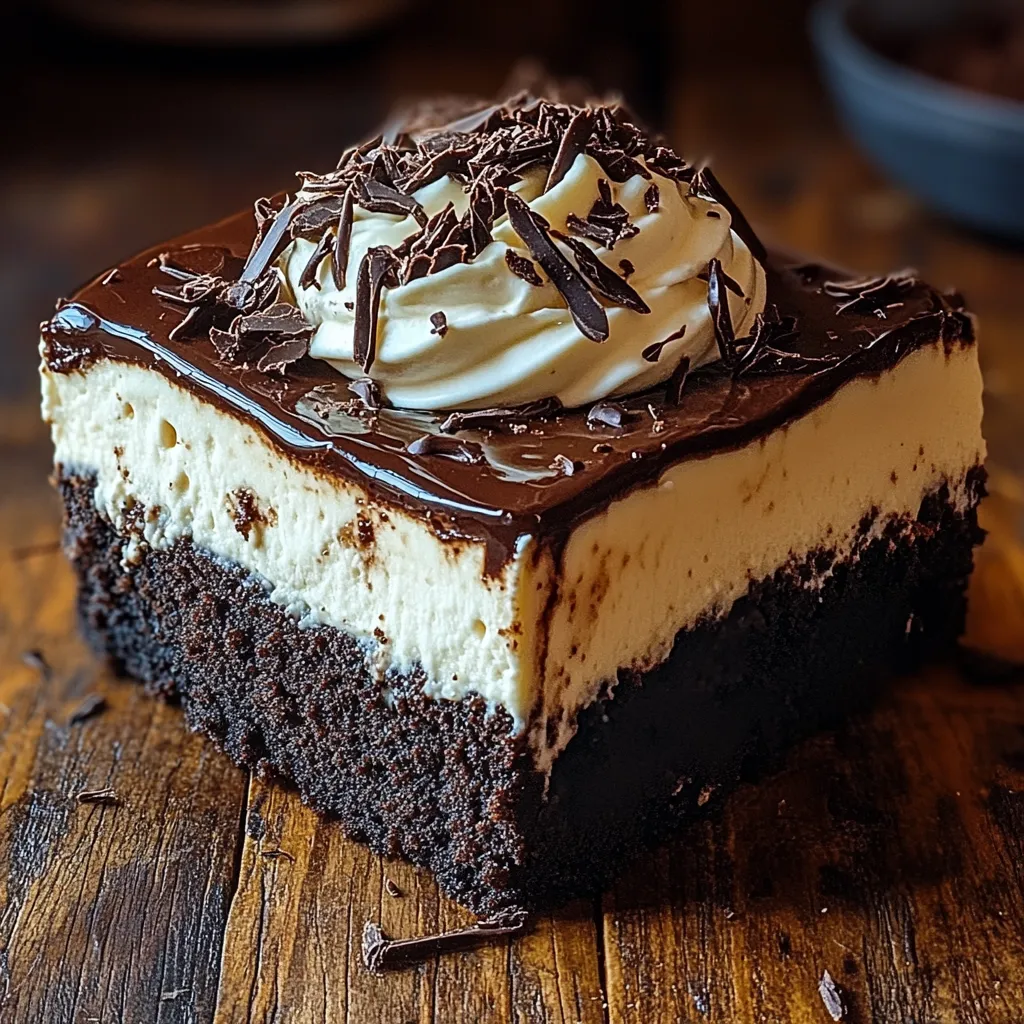 Pin it
Pin it
This decadent brownie bottom cheesecake brings together two beloved desserts in one irresistible treat. The fudgy brownie base provides the perfect foundation for the creamy cheesecake layer, creating a dessert that impresses at any gathering while being surprisingly simple to make.
I first created this recipe for my husband's birthday when he couldn't decide between brownies or cheesecake. Years later, it's still requested at every family celebration, and I've perfected the technique for achieving that perfect texture contrast.
Ingredients
- Unsalted butter: Gives the brownie layer richness while allowing you to control the salt content
- Semisweet chocolate chips: Melt slightly during baking creating pockets of intense chocolate flavor
- Cream cheese: Use full fat versions at room temperature for the smoothest texture without lumps
- Sour cream: Adds tanginess and creates a velvety texture in the cheesecake layer
- Vanilla extract: Enhances both chocolate and cream cheese flavors, use pure not imitation for best results
- Optional flour in cheesecake: Creates a slightly denser texture that some prefer for stability
Step-by-Step Instructions
- Prepare the Pan:
- Line your springform pan properly with parchment at the bottom and a light coating of butter on the sides. This crucial step ensures your masterpiece releases cleanly after chilling. I learned through several stuck cheesecakes that skipping proper pan preparation leads to heartbreak when serving.
- Create the Brownie Foundation:
- Mix your butter and sugar until it resembles wet sand before adding eggs one at a time. The brownie layer should be underbaked slightly around 20 minutes as it will continue cooking during the cheesecake phase. Look for moist crumbs not a clean toothpick when testing doneness.
- Perfect the Cheesecake Mixture:
- Room temperature cream cheese is absolutely essential here. Cold cream cheese will leave lumps no matter how long you mix. Beat the cream cheese alone first until completely smooth before adding any other ingredients. When adding eggs go slowly incorporating one at a time and scraping down the sides of the bowl between each addition.
- Bake with Patience:
- The cheesecake should bake at a lower temperature than the brownie layer. Look for a slight jiggle in the center like firm Jello when it's done. Avoid opening the oven door during baking as temperature fluctuations cause cracks. The gradual cooling in a slightly open oven prevents the dramatic temperature change that causes cheesecakes to sink and crack.
- Chill Thoroughly:
- Resist the temptation to cut into your creation too soon. The overnight chill not only sets the texture perfectly but also develops the flavors beautifully. I find the taste is significantly better after a full 24 hours of refrigeration when all the components have had time to meld together.
 Pin it
Pin it
The secret to this recipe's success lies in the quality of the cocoa powder. I discovered that Dutch process cocoa produces a deeper chocolate flavor in the brownie layer that perfectly complements the tangy cheesecake. One memorable Christmas, my niece declared it better than any restaurant dessert and secretly took an extra slice home in her purse.
Preventing Cracks
The most common issue with cheesecakes is surface cracking. While cracks don't affect the taste, they can impact the presentation. Ensure all ingredients are at room temperature before beginning. When mixing, use a low speed after adding the eggs to prevent incorporating excess air. Most importantly, allow the cheesecake to cool gradually in the oven with the door cracked open. If cracks do appear, use the optional toppings to cover them beautifully.
Make It Your Own
This recipe serves as a wonderful base for creative variations. Try adding a teaspoon of espresso powder to the brownie layer to enhance the chocolate flavor without tasting like coffee. For a festive touch, incorporate a tablespoon of orange zest into the cheesecake layer during the holidays. Mint extract works beautifully in the cheesecake portion during summer months. You can also swap the semisweet chocolate chips for white chocolate, butterscotch, or peanut butter chips based on your preference.
Serving Suggestions
For an elegant presentation, dust the top with cocoa powder using a fine mesh sieve and a paper doily to create a lace pattern. Alternatively, drizzle with warm ganache made from equal parts heavy cream and chocolate. When serving, warm your knife in hot water and wipe clean between slices for restaurant quality presentation. This rich dessert pairs beautifully with fresh berries, a scoop of vanilla ice cream, or simply a good cup of coffee.
 Pin it
Pin it
This dessert is a labor of love that rewards you with every bite. Trust the process and enjoy the indulgent results!
Frequently Asked Questions
- → Can I make this dessert ahead of time?
Yes! This dessert actually benefits from being made ahead. For best results, prepare it 1-2 days before serving and keep refrigerated. The flavors deepen and the texture improves with time.
- → Why did my cheesecake crack on top?
Cheesecake cracking typically occurs due to sudden temperature changes. To prevent this, allow the cheesecake to cool gradually in the oven with the door cracked open, and avoid opening the oven during baking.
- → Can I freeze brownie bottom cheesecake?
Absolutely! Once completely cooled, wrap the cheesecake (whole or sliced) tightly in plastic wrap and then aluminum foil. Freeze for up to 2 months. Thaw overnight in the refrigerator before serving.
- → Can I use a different size pan?
While a 9-inch springform pan is recommended, you can use an 8-inch or 10-inch pan. With an 8-inch pan, the layers will be thicker and require longer baking time. With a 10-inch pan, the layers will be thinner and may need less time.
- → How do I know when the cheesecake layer is properly baked?
The cheesecake is done when the edges are set but the center still has a slight jiggle when gently shaken. It should not be completely firm, as it will continue to set while cooling. An internal temperature of 150°F (65°C) indicates it's properly baked.
- → What can I substitute for sour cream?
Greek yogurt makes an excellent substitute for sour cream in the cheesecake layer. It provides similar tanginess and creaminess while being slightly lighter.
